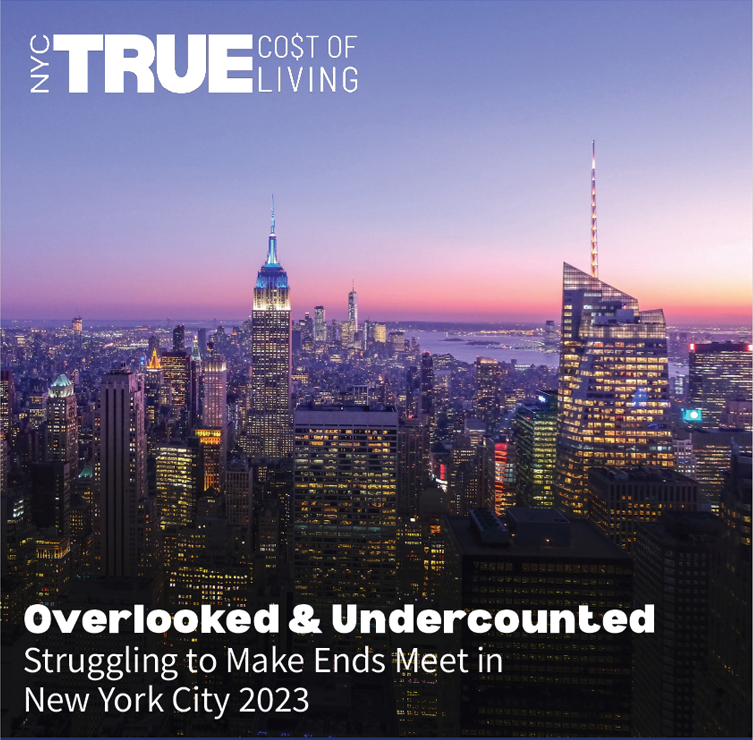The NYC True Cost of Living report (formerly the NYC Self-Sufficiency Standard) measures how much income is needed to meet families’ basic necessities, without any public or private assistance. We use the NYC True Cost of Living to better understand the realities so many of our neighbors are facing. Read the report and learn more at www.truecostofliving.org
2023 Report
Author: Center for Women’s Welfare at the University of Washington
Sponsors: Fund for the City of New York & United Way of New York City
Partners:
Association for Neighborhood & Housing Development
Citizens’ Committee for Children of New York
City Harvest
City University of New York
Community Service Society of New York
CUNY Urban Food Policy Institute
Equity Advocates
Food Bank for New York City
FPWA
Human Services Council of New York
Hunger Free America
KAVI (Kings Against Violence Initiative)
National Association of Social Workers – NYC Chapter
New York City Employment and Training Coalition
New York Coalition for Asian American Mental Health
New York Common Pantry
Part of the Solution (POTS)
PowHer New York
Precious First Step Child Development Center Inc.
Teachers College, Columbia University
The Catholic Charities of the Archdiocese of New York
UJA-Federation of New York
Women’s Housing and Economic Development Corporation
Questions: Contact communications@fcny.org or Caroline Andoscia at 917-207-4060 or caroline@andoscia.com
Read the Report

Frequently Asked Questions
Learn more about the NYC True Cost of Living
Please visit page 43 of the 2023 report for a complete methodological overview.
The primary data sources are:
- The American Community Survey, produced by the U.S. Census Bureau
- The New York State Child Care Market Rate Survey, produced by the New York State Office of Children and Family Services
- Fiscal Year (FY) Fair Market Rents (FMRs) data, produced by the U.S. Department of Housing and Urban Development (HUD)
Please visit page 46 of the 2023 report for a complete overview of data sources.
For more information, please refer to Measuring Poverty and the True Cost of Living in the U.S..
The Brooklyn and Manhattan divisions are based on differences in the cost of housing. Please visit page 45 of the 2023 report for more information.
Housing costs in Manhattan (New York County) and Brooklyn (Kings County) are adjusted for variation between two geographic areas of Manhattan and Brooklyn. The 2021 American Community Survey median gross rents for sub-boroughs within Manhattan
were used to adjust housing costs for what is referred to as “North Manhattan” and “South Manhattan” in this report. Note that these areas do not necessarily align with the commonly understood geographic boundaries of Lower and Upper Manhattan. The two areas were determined by grouping together sub-boroughs with similar housing costs. The traditional border of 14th Street
for Lower Manhattan left out high housing cost areas such as Chelsea, Clinton, Turtle Bay, and the Upper East and Upper West Side. The geographic area of North Manhattan for the purposes of this report includes the following sub- boroughs: Morningside Heights/Hamilton Heights, Central Harlem, East Harlem, and Washington Heights/Inwood. The sub-boroughs included in the geographic area of South Manhattan are: Greenwich Village/ Financial District, Lower East Side/ Chinatown, Chelsea/Clinton/Midtown, Stuyvesant Town/Turtle Bay, Upper West Side, and Upper East Side.
Northwest Brooklyn includes the following sub-boroughs: Williamsburg/Greenpoint, Brooklyn Heights/Fort Greene, and Park Slope/Carroll Gardens. The sub-boroughs included in the remainder of Brooklyn include: Brownsville/Ocean Hill, Bedford-Stuyvesant, East New York/Starrett City, Coney Island, North Crown Heights/Prospect Heights, Flatlands/Canarsie, East
Flatbush, South Crown Heights, Sheepshead Bay/Gravesend, Bensonhurst, Bushwick, Bay Ridge, Sunset Park, Borough Park, and Flatbush.
Please reach out to communications@fcny.org or Caroline Andoscia at 917-207-4060 or caroline@andoscia.com